#spectember 2023
Text
Spectember/Spectober 2023 #10: Tree Goat
An anonymous submitter asked for an "arboreal goat with grasping sloth-like claws":
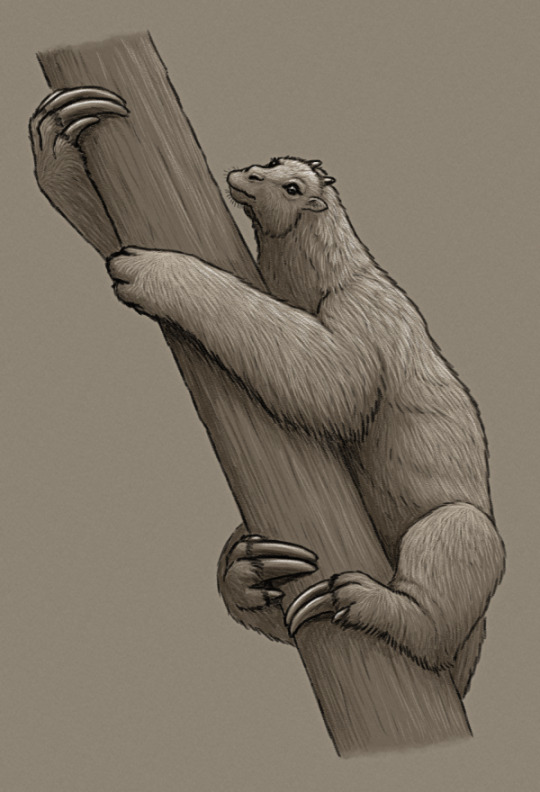
Cluraix cephalula is a distant descendant of feral goats in a tropical forest environment, representing a small tree-climbing offshoot of a specialized chalicothere-like lineage.
About 70cm long (~2'4"), it clambers around in the high tree canopies, with its forward-facing eyes providing good depth perception in this complex three-dimensional habitat. Its long hooked claw-hooves are used both to cling onto branches and to hook-and-pull clumps of foliage towards itself, stripping the leaves with its flexible fleshy lips.
#spectember#spectober#spectember 2023#speculative evolution#goat#artiodactyla#ungulate#mammal#art#science illustration
263 notes
·
View notes
Text
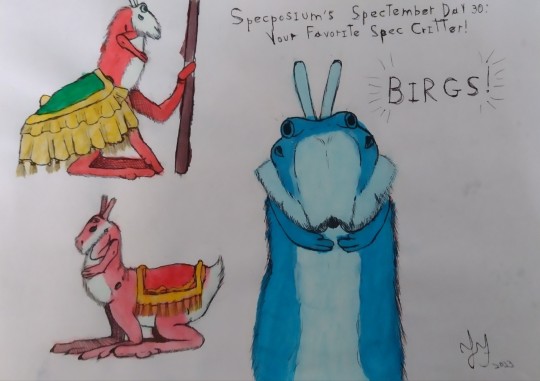
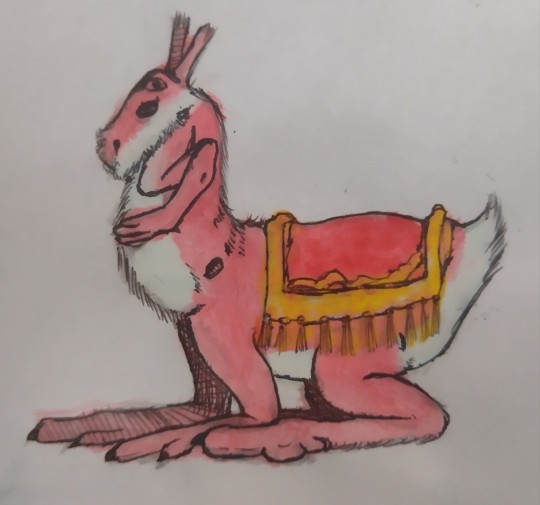


Specposium's Spectember day 30: Your favourite spec critter!
I like many spec projects but one that i like the most is @iguanodont Birgworld here on Tumblr. The birgs are simply so charismatic and nice to draw so i used this as an exercise with gouache, i like it, in the middle of the process i hated it but it came out nicely after the lineart. Not sure about birg's color variety tho.
This was a nice spectember challenge and it was a good exercise at spec and art, looking forward for the next one. Back to the normal posts now.
#birgworld#birg#fan art#specposium#spectember#spectember 2023#worldbuilding#art#illustration#spec bio#speculative biology#spec evo#speculative evolution#speculative zoology#alien#alien species#alien sophont#my art
283 notes
·
View notes
Text
Spectember day 17 - evolutionary history of dragons
yet again reusing old art because i am still too tired to draw new stuff
all modern dragons are descended from a hexapodal ancestor; the salamander
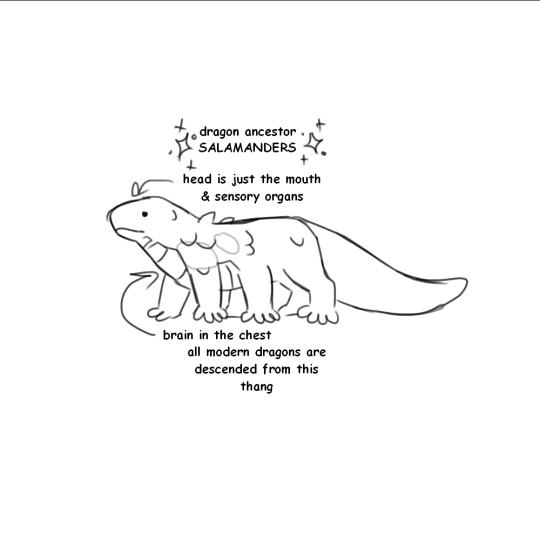
(all further drawings show the nostrils on the head which was a mistake oops. they're not supposed to be on the head but i also haven't decided where they should be yet)
dragons have split into a multitude of clades, and I'm focusing on wyverns (flying dragons) & drakes (bipedal, arboreal dragons), but there are also lindwyrms (long, serpentine dragons), hydras (dragons that have turned a variety of limbs into false heads), and sea serpents (aquatic dragons)
wyverns started out small, gliding from treetop to treetop with a membrane that stretched between their limbs and tail. somewhere along the line, they started evolving powered flight, and the two outer fingers on their middle legs grew to accommodate this

eventually this grew into the fully fledged wings that wyverns have today. sapient wyverns have, on average, a wingspan of about 15ft (4.5m). larger wyverns do exist, but the vast majority of them are smaller than this
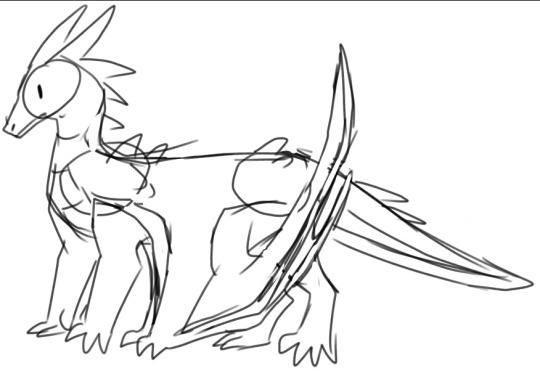
the history of drakes is a lot simpler than wyverns: they learned to climb trees. they're like the monkeys of the dragon world, helped along by thumbs on every foot & a prehensile tail
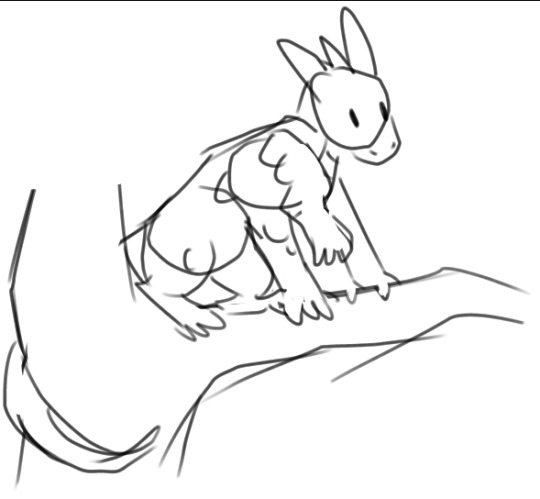
they love to scamper and scurry and scuttle
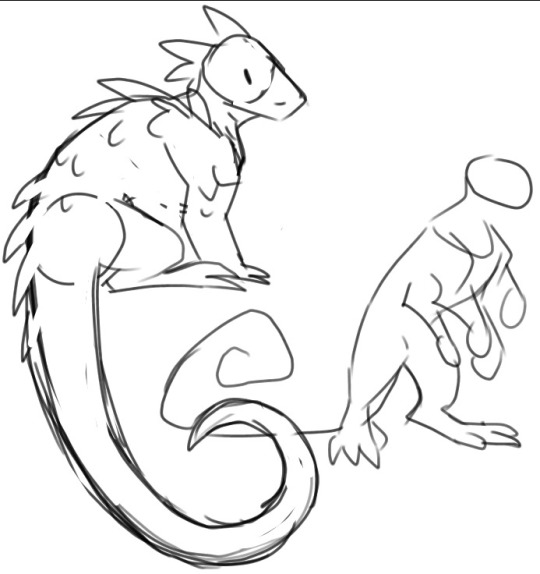
#spec bio#speculative biology#spec evo#speculative evolution#xenobiology#spectember#spectember 2023#world tag: ased
120 notes
·
View notes
Text

Wanted to prioritize a Spectober/Spectember post before getting to asks.
The masaka share their evolutionary tree with countless species of four-legged (sometimes two legged) small invertebrates, adapted to all sorts of ecological niches. They have their brains and eyes on their posterior side, and the cephalothorax with mouth on their anterior.
Donelja's a big fan. Their career in desert conservation on the terraformed masaka moon largely involves studying how the insects are doing (insect herbivory, population surveys ect.)
#selkra scribbles#my art#brokenyolkgalaxy#broken yolk galaxy#masaka taxonomy#donelja#alien#speculative biology#worldbuilding#xenofiction#speculative zoology#xenobiology#astrobiology#spectober#spectember#spectember 2023
73 notes
·
View notes
Text
Spectember Day 5) Flying Eurypterid... I had a lot of fun drawing this one. And really like how it turned out.

The Rocketeer Armora is a species of Eurypterid native to the southern continent of my world. Its name comes from the way it shoots itself out of the water to escape predators. This method of rocketing out of the water also helps it catch prey above the surface of the water, such as any large gulls and pterosaurs. The Rocketeer Armora lives in the many giant rivers and lakes on the continent as well as hanging about the coastal regions and many islands in the continent inland sea...
74 notes
·
View notes
Text
Spectember Promplist
Me and my friends made this one!
Go wild with these, and be sure to have fun!

Sheet drawn by @zenwyrmmess
#speculative biology#spec evo#spec council#speculative ecology#speculative zoology#speculative evolution#Spectember#Spectember 2023#worldbuilding#creature design#spec bio
81 notes
·
View notes
Text
IT'S SPECTEMBER AGAIN!
Unfortunately college is starting again this September so I won't be able to post a lot until we get a vacation. But still I'll be leaving a fun little thing for the occasion:
A DTIYS (Draw This In Your Style!)
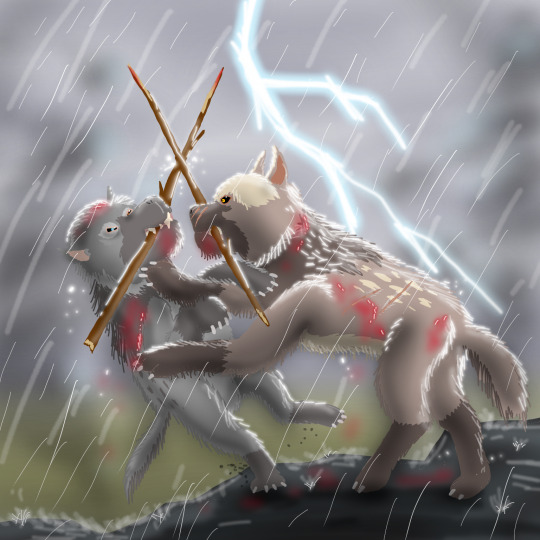
Tag your entries under "#hamster's paradise DTIYS". I'll reblog the top ones at the end of the month. You can change up the poses and angles as long as you keep the climactic one-on-one clash in the thunderstorm.
Have fun and enjoy!
-----------
#speculative evolution#speculative biology#spec evo#speculative zoology#hamster's paradise#the calliducyon saga#hamster's paradise DTIYS#spectember#spectember 2023
99 notes
·
View notes
Text
Spectember 2023
For this year’s Spectember I present to you the world of Earth, about 15 million years in the future, during the Ultracene epoch. This is a little project I’ve been working on on-and-off, and which I often use as a kind of “dumping ground” for spec concepts that don’t fit into any of my other projects. It’s a mixed bag of good, bad, and mediocre, and over the course of this month (weekends excluded; I do have a schedule, but it’s anyone’s guess if I can keep to it) I’ll be showing you some of my favourite concepts from this project.
DAY 1: Welcome to the Ultracene

15 million years in the future, the world has changed. The Anthropogenic mass extinction has brought an end to the Pleistocene Glaciation, and the world is now hot, wet, and verdant, much as it was in the ancient Paleocene. The deposition of massive amounts of greenhouse gases by humanity irreversibly altered atmospheric composition, and the subsequent high global temperatures melted ice sheets and caused sea levels to rise by nearly 100 meters. Vast tracts of South America, Eurasia, and Australia are now underwater. As a result of the increase in the ocean’s surface area and temperature, the atmosphere has much more water vapor in it, leading to higher precipitation across the globe; deserts like the Sahara are much wetter, sandy wastes replaced by rolling savannahs and grasslands.
The continents have changed, as well. Tectonic activity has led to the collision of western Africa with southern Europe, closing the strait of Gibraltar and raising up the Castillian Mountains where the western Mediterranean used to be. East Africa has broken away from the mainland to form a new island continent, Somalia. And Arabia has crashed into Iran, opening the strait of Suez into the Indian Ocean and pushing up the Zagros Mountains until they rival the Himalayas in height. In the western and southern Pacific Ocean, volcanic activity has led to the generation of new island chains and the enlargement of old ones. Australia has drifted north and collided with New Guinea. And so on and so forth.
The changing climate and colliding continents, combined with the action of humans in the modern era, have had serious effects on the biogeography of animal species. North America, for example, is now home to old-world pythons and monitor lizards. Descendants of the hippopotamus thrive in the swamps and coastlines of South America, and Elephants and Hyenas once again range across the palearctic, from Spain to Siberia. Humanity itself has succumbed to the ravages of time, having been devastated by mosquito-borne illnesses in the aftermath of the apocalypse; but the world they created lives on, forever bearing the indelible mark of the upright ape.
Over the next month, I will take you on an adventure through the wildlife of this strange new world. From Arctic Macaques to Arboreal Sharks, from the austere grasslands of Greenland to the stormy Argentine Sea, this world is at once intimately familiar and undeniably alien. Come with me, my friends, on this journey to the future. Welcome... to the Ultracene.
(Map modified from one created by Reddit user m4nu. I moved the continents around according to my basic understanding of tectonic plate movement speeds and directions, and added biomes where I thought they should go. Take it with a grain of salt - I study ecology, not geology or meteorology.)
#So I started a thing#God only knows if I shall finish it#I have a schedule but September's gonna be a busy month and I dunno if I'll be able to keep up#spec evo#speculative evolution#future biogeography#future evolution#spec bio#speculative biology#ultracene#Spectember 2023
29 notes
·
View notes
Text
Spectember #3 – Stone Eater: Clechihebog

The stone eating shipworm, larger than their ancestor.
This animal was a cave dweller, and found near the caverns connected with river or subterranean river as new habitat. Clechihebog is the armored shipworm evolved from the challenges until evolved into larger, but smaller than average land crabs 😮
Clechihebog was the English word from Scottish Gaelic word is "clach bheag ag ithe" and scrambled into their form "Clachithebhég", which means "small stone eating."
#ognimdo2002#earth responsibly#science fantasy#earth#art#earthresponsibly#fairytale#future#speculative evolution#ibispaint art#spectember#september#clechihebog#shipworm#rapunzles tangled adventure#mollusk#spectember 2023#art ph
6 notes
·
View notes
Text
09/09/23
To all my fellow early celebrating halloween friends 👻🎃🧙
#halloween#halloween decorations#halloween deco#early halloween#spectember#2023#spooky#scary#cute#horror#decor#house#cozy#comfy#lights#candle#pumpkin#ghost#pumpkinpie#skelleton#tumblr#aesthetic
3 notes
·
View notes
Text
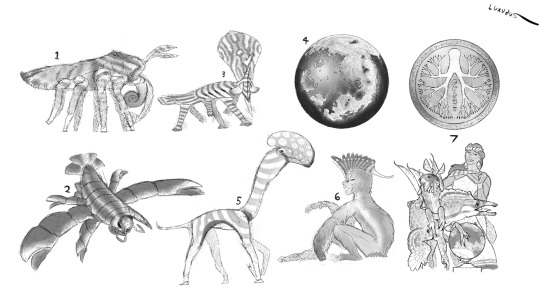
Took me long enough but heres the sequel to the september cutting room floor. Ending this series for good. Staring in order by their number Starting with the entries made for 2022
1. A mammaloid alien native to a dangerously cold planet iconic for it’s red and blue plantlife. They are skittish herbivores. Grazing along its planet’s “grass” by grabbing handfuls of plants with its oral tentacles and brought it to a mouth located in a hollow space in between its oral tentacles and head. And would sport vibrant patterns to blend in with it’s equally colorful forests
2. Originally a suggestion by my friend Lemuel. They were a descendent of pill bugs/roly polies that evolved powered flight. They soared through forest understories with three sets of flattened legs and held onto branches with their hind pairs of limbs. In spite of the radical change to their movement, they would still act and eat like any other Armadillidiid Isopod. Only now they could get to their food much faster
Now onto the entries made for 2023.
3. An alien predator that has all of our senses, but none of the familiar organs. They see the world with an organic sonar dish so powerful it could see colors as good as any eye. They smell and feel heat through heat pits on the sides of their body. They hear sound through sensitive whiskers on the feet of their hydraulic legs. And they eat and taste with a liquivorous proboscis.
And on top of their unique sensory organs and a testament to their overwhelming success, they are also freakishly intelligent. Not fully sophont, but still able to run circles around earth’s smartest life aside from humans.
4. An orbital view of a carbon planet. A hypothetical world where it and the rest of it’s star system formed with much more carbon in its composition than standard oxygen. In place of water would be oceans and clouds of hydrocarbons. And nestled right in between the crust and mantle would be a hundred-kilometer-thick layer of pure diamond.
Sadly how life would evolve and take advantage of such a world was never conceptualized before spectember ended. Maybe someday this idea can be covered again and be brought to justice.
5. A descendant of azhdarchid pterosaurs from the same world (or at least set of timelines) as the aforementioned Dinosauroids. They live in hierarchical herds where the strongest males have ownership over the herd’s female members.
They are also extremely violent, capable of killing their own predators if a hunt goes slightly wrong, And changes in power often escalate into bloody fights that could end in death. Some members are even willing to kill their herd mates' children if it means they get a chance to continue their bloodline.
6. A descendant of the golden snub-nosed monkey that has evolved to mimic the violet deathhead from my last official september post. Their fur is a speckled brown to blend in with the trees it lives on. The structure mimicking the deathhead sail is derived from nasal flaps once used to attract mates. The primate’s blue skin paired with clusters of veins within the nasal flaps create the iconic purple hue.
High concentrations of melanin along the tip of the nasal flaps mimic the black stripes. And even the orange spots are recreated by rows of unusually thin skin refract sunlight the same way the webbing between our fingers turns orange as a close light source passes through it
7. A dinosauroid microbiologist who lived in a time when their people colonized the solar system. A Chia’J-di ecologist who lived in a time when their species’ industrial revolution provoked an equally powerful environmentalist counterculture, the globe they are holding is earth 500 million years in the future and long after pangea ultima split, the version of earth their species hails from. And a masculine female human sophontologist who lived in the aztec empire during it’s height. All pose for a picture.
Despite their different walks of life and origins of separate timelines. They are all heads of research within the earth division of the Inter-Timeline Evolutionist Union, better known as the ITEU
The ITEU is a non-profit, nongovernmental secret organization spanning the entire multiverse. With the goal of documenting and archiving the evolution of every species and civilization that has ever lived and will ever live across every possible timeline.
Their employee count ranges in the quantifiable infinity, and the division of a single planet is still big enough to utterly dwarf the largest and most technologically advanced civilizations ever documented. And their membership program accepts anyone from individual sophonts like you and I, galaxy spanning gestalt super-intelligence, to even celestial deities that create their own worlds and galaxies and seed them with life.
The symbol above the heads of the earth division is the logo of the ITEU as a whole. Surprisingly very little is known about the meaning behind it. Theories range anywhere from it representing the multiverse as a stream of timelines. The evolutionary tree of life, the infinite fractal-like scale of life and the multiverse. To possibly even the form of the ITEU’s founding species.
There’s a very good reason why the logo is a mystery to all. The ITEU has some pretty big flaws in spite of their noble goal. The organization is very secretive, even to it’s own members. Nobody outside the ITEU knows it even exists. The organization’s founders and early history remain a complete mystery. And despite its multiversal span being common knowledge. no one truly knows the full scale of this organization or the multiverse.
They are also very non-interventionist, and will stop at nothing to not leave a mark on the natural world and make any irreversible changes to the course of time. Even if it means never sharing their knowledge with the multiverse’s most advanced civilizations. Allowing interdimensional atrocities to keep going despite having the power to stop it. Or even keeping their own members from ever returning home.
This whole entry was meant to be a bigger grand finale to 2023’s spectember instead of the Batesian mimicry ring or the neurodivergent posthumans. And was meant to be a meta look at 2023’s entries and the genre of speculative evolution as a whole before spiraling out into its own thing entirely.
(i apologize if the aztec woman appears culturally and/or racially insensitive, if anyone who's an expert on aztec culture wants to give feedback I'd appreciate it a lot i want to improve more on illustrating other cultures)
68 notes
·
View notes
Text
Spectember 2023 #06: Some Big Reptiles
An anonymous request asked for a "large ankylosaur-like herbivorous notosuchian":
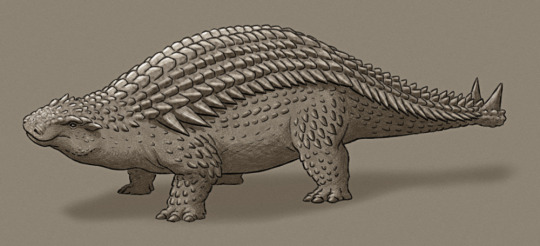
Mitafosuchus pachysomatus is descended from Simosuchus-like notosuchians in Madagascar that survived through the K-T extinction.
Highly convergent with the now-extinct ankylosaurs, it's a 5m long (~16'4") squat tank-like herbivore with hoof-like claws, and a wide short snout used for grazing on low vegetation. Heavy interlocking osteoderm amor covers most of its body, protecting it against the big carnivorous crocodyliformes that also still survive in this version of Cenozoic Madagascar.
———
Another anon wanted to see a "giant warm blooded lizard":

Atopohippus zestamenus is a descendant of invasive Argentine giant tegu lizards that became established on an island archipelago. At 2m tall (~6'6") and around 6m long (~20') it's an example of island gigantism, and occupies a high-browsing-herbivore ecological niche similar to giant tortoises and prosauropods.
Its ancestors' seasonal endothermy has become full endothermy in this species, partly due to young individuals having a very rapid growth rate and metabolism – their main defense against the predators on their island home (primarily carnivorous tegu-descendants and large birds of prey) is to simply get to a big body size as fast as they possibly can.
#spectember#spectember 2023#speculative evolution#notosuchia#crocodyliform#pseudosuchia#tegu#squamata#lizard#reptile#art#science illustration
272 notes
·
View notes
Text

Specposium's Spectember day 12: Alternate history
Wasn't sure about what to do today so here is a fun idea:
Mammaln't: In this universe mammals never evolved, yet cynodonts persisted trough the jurassic into today, evolving live-birth, endothermy, good hearing, erect limbs, everything that we seen in modern mammals, all but mammary glands themselves.
Instead of giving birth to altricial young who needs to feed on milk during their early stages, mammaln'ts have either a longer gestation period, giving birth to precocious young. Or giving birth to altricial young who are fed crop-milk or prey by the adults, much like birds.
Depicted is a wolf-like(in appearence) mammaln't.
#specposium#spectember 2023#spectember#worldbuilding#art#illustration#spec bio#speculative biology#spec evo#speculative evolution#speculative zoology#alternate universe#alternate history#my art
209 notes
·
View notes
Text
Spectember day 5 - leviathan planet fauna
4 different animals from the leviathan planet, starting off with what I’ve dubbed squidfish & raybirds. they share a distant common ancestor from which they inherited the same body plan, but they went in completely different directions with it
both are characterized by their radially symmetric body, with 4 eyes and a + shaped mouth. squidfish are the ones that stayed aquatic, with 4 large, flat tentacles to propel them through the water, and 4 fins along the body that they can move around as needed to help with steering. to a squidfish, all 4 sides are “up” and they can orient themselves whichever way they need to

raybirds migrated onto land and almost immediately took to the skies, turning their fins into wings. unlike squidfish, raybirds are limited to one specific side being up and one being down. two of their torso appendages have morphed into wings, with bony spurs used in offense and defense. the other two are attached to fans that male raybirds use to show off to potential mates. the top two tail appendages have attached to the wing membrane and assist in flight, with the other two growing strong and acting as a teeny little pair of legs

I don't have any info about these next two that isn't already on the images (or talked about on day 3 in the case of the 6 legged animals)
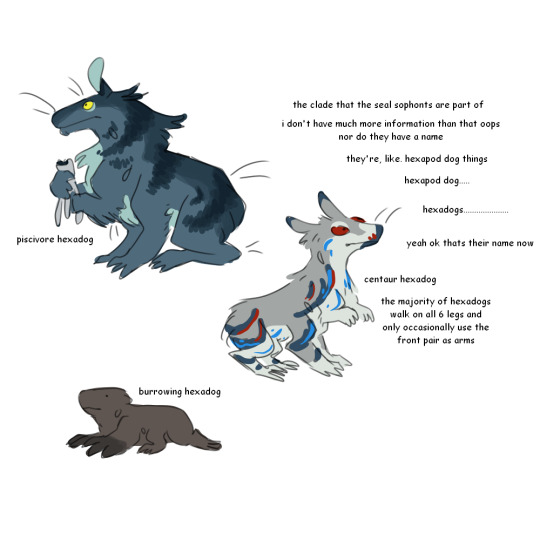

#spec bio#speculative biology#spec evo#speculative evolution#xenobiology#worldbuilding#spectember#spectember 2023#world tag: ased
83 notes
·
View notes
Text

Should not be typing or anything with a overstrained hand but boredom is maddening so I needed to at least write a thing. So behold; Daily Month Art prompt list for those who may want to make Speculative Evolution art with plants specifically.
Short FAQ
What is SpecEvo?
*sneezes in wikipedia-ese link*
Does this art challenge have to be completed during September 2023 and in chronological order?
No and no; Can be done any month, of any year (hence the "plus" after 2023 title), in any order you wish. You can even just do one of the prompts that catches your eye and call it at that; Despite me creating this prompt list, it's your choice whether to add those rules in for yourself or not. I know all too well how both fun yet stressful art prompt lists can be.
Can I circulate this Prompt list beyond tumblr?
Please do! I made this specifically to get more peeps thinking of SpecEvo Flora concepts and I know tumblr is only one bubble of many others out there with SpecEvo artists lurking about. Credits are optional, since the prompt list image comes with my tumblr url anyhow.
Can I @ or tag you the OP if I participate in this promptlist?
While I don't expect this prompt list to reach far I'd rather play it safe and say no, please don't to avoid a potential albeit unlikely barrage of @ notifs. Besides I may end up lurking said tag if it starts being used, the tag #FloraSpectmbr will suffice (I have intentionally shorthanded/misspelled Spectember to make it distinct enough that it should *hopefully* avoid flooding the followed tags of those who are doing the unrelated Spectember prompt lists that already exist out there, plz follow that intentional mispelling if you're doing this Botanical Edition)
#FloraSpectmbr#spectember#SpecEvo#Spec Evo#art prompts#prompt list#plants#botany#art#Speculative Evolution#flora
27 notes
·
View notes
Text
Spectember Day 1) Oldest spec critter.. For the first day of Spectember I rounded up my oldest spec creatures and redesigned them.. While this one is only a pencil sketch, I can promise y'all that I will be trying to do the rest of the months prompts in digital art
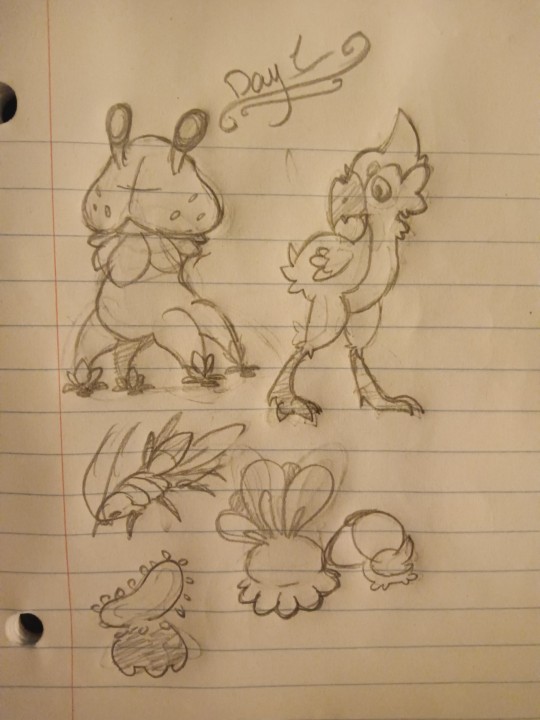
My favorite one has to be the mushroom.. I've reworked it into a motile fungus that had a symbiotic relationship with a species of flower. Allowing it to use photosynthesis to gain energy when food isn't easily available...
My second has to be the flying trilobite directly under the Flowery fungus..
12 notes
·
View notes